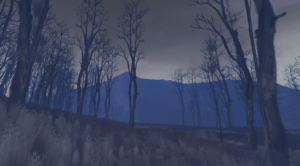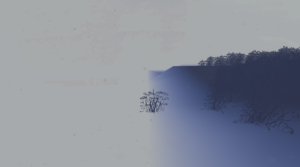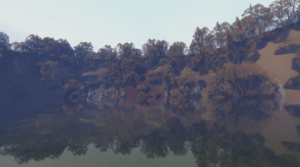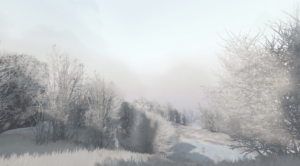How Walking Tells the Story in Places
In Places, the “story” behind each sketch and place is that it is a digital 3D painting that the player is meant to explore and admire. Walking serves as a means to tell this story by giving the player the mobility to traverse across a diversity of beautiful, realistic, and dynamic landscapes based on their own volition in terms of direction, orientation, and sequence of areas visited. The story is one of exploration and ultimately feeds into the game’s aesthetic of Discovery.

Name of game: Places (I playtested Sketch 1, Sketch 5, and Place 6)
Creator: ktch
Platform: Played on PC through the following link http://jlv.fi/places/
Target Audience: According to the Salon article on walking sims, the target audience for most games of this genre are newcomers to the video game space. Based on this WSWS Process Doc, walking sims target audiences typically of age 18-35.
Important Formal Elements of the Game
1.Players
Places is single-player game. In terms of interaction patterns, the game is set up to be Single Player vs Game. There are no other human players in this game pattern; instead, the singer player roams through the environment from a first-person perspective while searching for an unknown deeper truth (or concept of beauty) within the game’s surroundings.
2. Objectives

The main objective of this game is Exploration. On the home screen of the Places website, the following is used to describe the collection of sketches and places: “Places are small and atmospheric 3D paintings where one can walk around and spend a few minutes.” Beyond the beautiful displays of nature, there were no additional people or objects to interact with, nor puzzles or other gamified challenges to solve. Based on my experience with navigating through the places and sketches I chose, the objective of this game is to wander around the locations and to view and appreciate as much of the artistic elements of the scenery surround you as the player as possible.
3. Outcomes
The only two possible outcomes of this game are 1) to have explored the entire map, or 2) to have more of the map to explore. Regardless, there is no “winning” or “losing” state.
4. Procedures
The procedures of this game are fairly simple. The player is capable of moving forward, backward, leftward, and rightward using keys on a keyboard. The player is also capable of changing the orientation of their perspective using the trackpad or mouse of a computer. Coupled together, these two capabilities allow the user to move about steadily and freely in the open-world setting of the game.
Special actions the player is able to take include the ability to traverse up steep mountain terrain with no change in speed/pace. This is notable because the player is not constrained by the physical limitations they would have in a more real-world experience.
5. Rules
The rules for this game are very basic and intuitive as well. In order to explore more of the digital painting, the user must walk devote time to walking around the map.
6. Resources
The resources that the player is allotted in Places to achieve the objective of the game – to explore the digital landscape – are the player’s senses. Based on the sounds of feet stepping into grass/branches every time the player moves in any direction, it can be inferred that the player has resources for mobility in the form of legs and feet. The player is also able to appreciate their surroundings through the sounds of nature (wind, grass, air) provided by the game. The ability for the user to perceive their surroundings freely through a first-person perspective is perhaps the most important resource of all.
An additional notable resources is the unlimited time the user can allot to exploring the digital landscape.
7. Boundaries
The most obvious boundary of this game is the constraints of the map. Once the player reaches the edge of the digital painting (indicated by the fading of the landscape into white), the player is unable to move into the white space.

Another boundary the player is limited by is the pace of their walk. The player cannot speed up or slow down when moving across any type of terrain, and is restricted by the same steady pace.
Aesthetic of Fun
The aesthetic of fun intended by this game is Discovery, as the player is meant to explore the uncharted territory of their surroundings. The game was successful in meeting this goal through the design of its formal elements. Namely, the interaction pattern of Player vs Game enables the player to immerse themselves fully into their environment without the distraction of other players. This is important, because the process of discovery is usually a very personal process that must be performed at a personalized pace.
Further, the fact that the Outcomes of this game do not include a winning or losing state relieves any pressure from the user to skip over any of the environment’s details for the sake of trying to “win.” To add to that, the lack of any side objective besides exploring the digital painting enables the player to focus on exploring and only exploring. If, for example another objective were introduced (such as “find all the pieces of this puzzle”), the user could run into the risk of navigating quickly through the landscape with solely that objective in mind, and miss out on appreciating the beauty of the landscape. As a result, the game’s lack of additional purpose or incentive to win along with the unlimited time the user has to spend in the game sets a relaxed, steady, and peaceful tone to the game that enables the player to concentrate on fully appreciating its Discovery aesthetic.
Finally, the lack of strict or complex Procedures and Rules to this game contributes to the already open-world style of the game, contributing to the user’s breadth of freedom. The freedom allotted to the user thus gives them more space, room, and means to explore the surrounding environment, furthering the aesthetic of the game.
Moments of Particular Success or Epic Fails
Moments of success that were particularly noteworthy include the delight I felt when I realized I could just walk up mountains with no problem. The fact that the laws of gravity did not apply to me when in this game made me feel like I had even more freedom to explore and discover more of the terrain.
Another moment of delight I experienced was when I tread into water in Place 6 and splashing noises ensued as I continued to swim through it. The extra element of water was a pleasant splash of variety (literally!).

Other moments of success I felt were the moments when the beauty of the landscape was simply striking to me. The level of detail put into making the graphical details as realistically shaded as possible and the dream-like, breathless beauty of the environment made the experience feel almost ethereal.

Although I wouldn’t consider this an epic fail per say, one flaw of the game was that I got bored of each place/sketch I visited after a few minutes of exploring. Each location was somewhat monotonous, so that after I explored each scene for awhile, even the places I hadn’t visited before didn’t seem new.
Suggested Improvements for the Game
One improvement I would love to suggest for this game would be including ways for the player to interact with the environment beyond just walking through and looking at it. If the player were able to do simple things like cut grass or pluck leaves from trees, it would add a sense of “touch” to the game and perhaps enable the player to appreciate the experience more and contribute to its aesthetic of fun.
I would also recommend incorporating more diverse natural elements to each sketch and place to reduce the monotony of each location. For example, the body of water in Place 6 was a welcome addition to the usual grass and trees present in Sketch 1 and 5. This would reduce the risk of the player quickly become bored, and instead encourage further discovery, adding to the game’s aesthetic!


